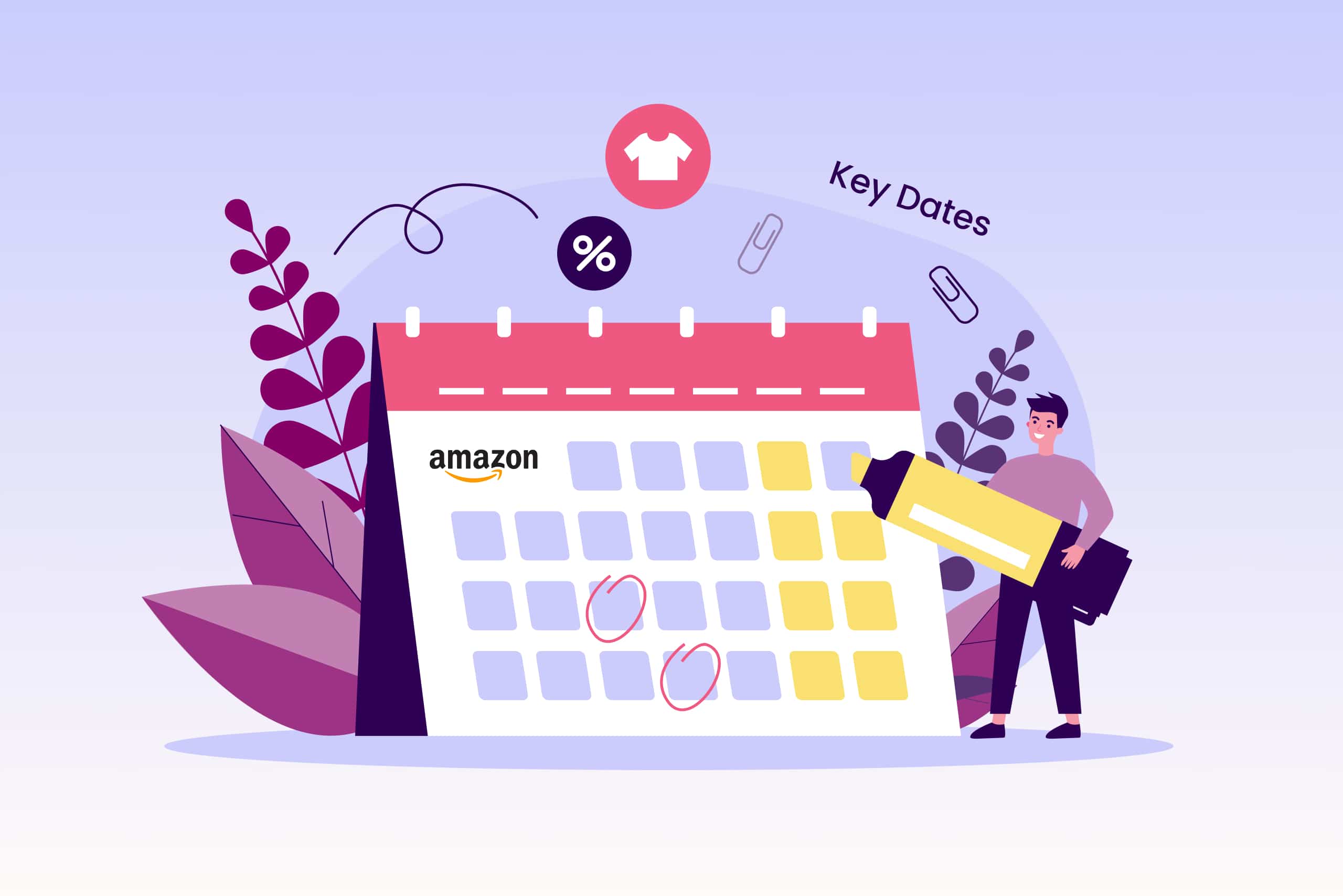Amazon peak season is the time when there’s a surge in demand for products across the platform. For many sellers, peak season is by far their biggest earning period. Being able to predict these peaks, manage your stock levels and run promotions at the right time of year can greatly improve your turnover and profits.
Key takeaways
- To fully take advantage of peak seasons, it’s vital you’re aware of any major public holidays or important seasonal events that are coming up.
- Keep in mind that most people buy gifts, back-to-school items, or merchandise several weeks in advance of the holiday or event in question.
- Ensure you have inventory ready to go and are running your PPC marketing campaigns early enough to capture sales.
When is Amazon’s peak season?
The peak period for selling on Amazon is usually between October and January, due to major holidays such as Thanksgiving and Christmas. This time of year also includes major promotions such as Black Friday, Cyber Monday, and Super Saturday. While this sweet spot is coined as the peak selling season, there are also other major holidays that see small peaks in sales.
Key dates for Amazon sellers in 2024
As mentioned, other major holidays contribute to smaller peaks in sales on Amazon. That’s why it’s crucial to keep a close eye on the calendar and plan your PPC and marketing strategies accordingly. Here are some key dates to consider that might help you come up with ideas to optimize your product listings around seasonal events:
Q1 Key Dates
January
Many sellers run promotions in the new year, and bargain hunters expect to see good deals during the first month of the year. Fitness and lifestyle products sell particularly well among people who have made health-focused New Year’s resolutions. Here are some dates to plan your deals around:
- 1st: New Year’s Day
- 15th: Martin Luther King Day
February
Moving into February, there are two main events to keep an eye on. Superbowl-related paraphernalia sells well leading up to the second Sunday, and there’s also a market for romantic gifts in the run-up to Valentine’s Day. These mid-February dates are the ones to focus on:
- 11th: Super Bowl Sunday
- 14th: Valentine’s Day
March
As springtime comes around, St. Patrick’s Day provides a welcome opportunity to party just before spring. Another poignant day to mark on the calendar is International Women’s Day, which is a great time to celebrate women around the world and highlight the women working at your organization.
In 2024, the Easter holidays fall at the end of the month, so take the chance to cash in on the rush as everyone gets ready to celebrate and decorate for this pastel and chocolate-focused event.
- 8th: International Women’s Day
- 17th: St Patrick’s Day
- 29th: Good Friday
- 31st: Easter Sunday
Q2 Key Dates
April
April also offers up a change of seasons, making spring clothes and cleaning items popular purchases this time of year. Without Easter landing in April, there are just a couple of dates to be aware of heading into spring. Namely, Earth Day and Arbor Day fall within the same week, reminding shoppers (and brands) of the importance of taking care of our planet:
- 22nd: Earth Day
- 26th: Arbor Day
May
American Flag-related items sell well in the run-up to Memorial Day weekend, While cards and luxury gifts for women are big sellers around Mother’s Day.
- 12th: Mother’s Day
- 27th: Memorial Day
June
June sees the start of summer, as many start to plan their holidays and go searching on Amazon for products to match. Think pool and beachside attire and accessories, plus anything to do with spending time outdoors. June is also synonymous with Father’s Day, so consider this the time to promote your products for men.
- 14th: Flag Day
- 16th: Father’s Day
- 19th: Juneteenth
Q3 Key Dates
July
Amazon shoppers love July, because Prime Day is now 48 hours long! Take advantage and make an effort to make your products stand out to all the people looking to snag a good deal. It’s worth noting the exact dates have not been announced just yet, but our estimation is likely to occur around 2023’s dates (July 11th and 12th).
- 4th: Independence Day
- 12-13th (approximately): Prime Day
August
Individual schools can set their own dates for the start of the academic year, but most schools go back in the middle of August. Start promoting your back-to-school range early so you can catch those frazzled parents shopping for stationery kits, lunch boxes, and electronics.
- 15th: Back to School Day
September
As many turn their eyes to fall, the last long weekend of the summer season comes to a close with Labor Day. This is a great time to provide deals and run promotions around summer items as shoppers begin to turn their attention to fall products. In addition, the NFL starts their season in September. The exact date is announced earlier in the year, so pay close attention to the lead-up and plan your products accordingly.
- 2nd: Labor Day
Q4 Key Dates
October
October is a transitional season where shoppers are gearing up for the end-of-year festivities. Plus, the NBA and NHL are back with their season openers, which can bring in numerous shoppers. Undoubtedly the biggest holiday of the month, Halloween is huge for many households, so don’t ghost your shoppers on plenty of deals!
- 14th: Columbus Day
- 31st: Halloween
November
As cooler temperatures creep in and winter is on everyone’s minds, focus on season products that tend to be big sellers. The traditional peak season for Amazon starts in November and retailers prepare to take advantage of the shopping frenzy over the following days. Black Friday is some seller’s busiest day of the whole year. Ensure you’re prepared for the demand!
- 28th: Thanksgiving
- 29th: Black Friday
December
When it comes to December deals, brands feel the frenzy leading up to Christmas. Ensure you’re aware of the last postage days for the countries you sell to on Amazon, and base your promotional efforts around those days.
- 2nd: Cyber Monday
- 26th: Boxing Day (in Canada and the UK)
- 31st: New Year’s Eve
How Amazon sellers should prepare for peak seasons
Preparing for peak seasons looks different for every Amazon seller. Perhaps your specialty soaps are snapped up around the winter holidays but move a bit slower in the springtime. Or maybe your novelty socks are a customer-favorite year-round, but you want to experience a surge in sales a bit more regularly. Planning your marketing strategies and stock levels around peak seasons doesn’t have to be a challenge, and with these tips, you can seize the sales you’re looking for:
Forecast your sales volume
To ensure you don’t miss out on sales due to stock issues, forecast your sales volume based on comparing previous periods where your revenue was high. Look at your competitors and see how they fare, and try to anticipate market trends. If one of your products has a high CTR, but the conversions don’t match up, consider coming up with a promotion for this item and stocking up on it before you’re ready to put it on sale.
Create a stock order plan
Once you have a sales forecast, you can create a stock order plan. Aim to maximize stock availability around peak times, so you don’t end up with a stock shortage, or a surplus of products sitting in the warehouse taking up valuable space.
Optimize product listings
Take some time to optimize your product listings so they stand out in the search results over the peak periods. A good product listing includes eye-catching images, relevant keywords and a description that conveys what the product is useful for.
Bullet points laying out key specifications can be helpful for buyers to understand what the product is and whether it meets their needs.
Schedule your marketing activities
As an FBA seller, you’re probably juggling a few tasks, including managing your listings and planning out marketing campaigns. To avoid missing out on sales over the peak season, devise a plan to determine and pre-schedule your PPC marketing and social media ads.
Leveraging a tool like Trellis means building out your marketing campaigns for the next few months doesn’t have to take up weeks of your time. From keyword research to listing optimizations, our software combines AI and automation to streamline your efforts. We can lend a hand when it comes to content creation and even dynamic pricing to help you stay ahead of your competitors, no matter your peak season.
Get a backup fulfillment option
Amazon’s FBA is a great service, but if you’re 100% reliant on it, you’re putting your business at risk. Even if you’re on an FBA professional plan, it’s still a good idea to have a backup. This was highlighted during the pandemic when Amazon briefly paused fulfillment for orders of non-essential items. To avoid having all your eggs in one basket, consider balancing between FBA andFBM (fulfillment by merchant. This gives you more control over how your order fulfillment is managed.
Prepare your customer service team
If you have a flurry of sales activity, this is likely to bring in a wave of customer questions and concerns. Ensure your customer service team is ready.
Your customer service agents should know when you’re running promotions, what products are likely to attract the most attention, and enough about the products to be able to provide useful and personal service.
Providing good customer service, especially at peak times, helps your business stand out from the crowd and can be the differentiating factor that encourages first-time customers to come back to your brand the next time they’re shopping on Amazon.
Get the most out of Amazon peak season times with Trellis
At Trellis, we offer a variety of tools to help Amazon sellers take advantage of peak seasons. From keyword research tools to listings analyzers, our tools can help you find the best products to promote and optimize your listings for maximum discoverability and sales. Our AI-powered software can help you maximize your market share and build a strong base of repeat customers to boost your ongoing revenue.
If you’d like to know more about how we can help you grow your brand on the Amazon marketplace, contact us today to book a demo.



